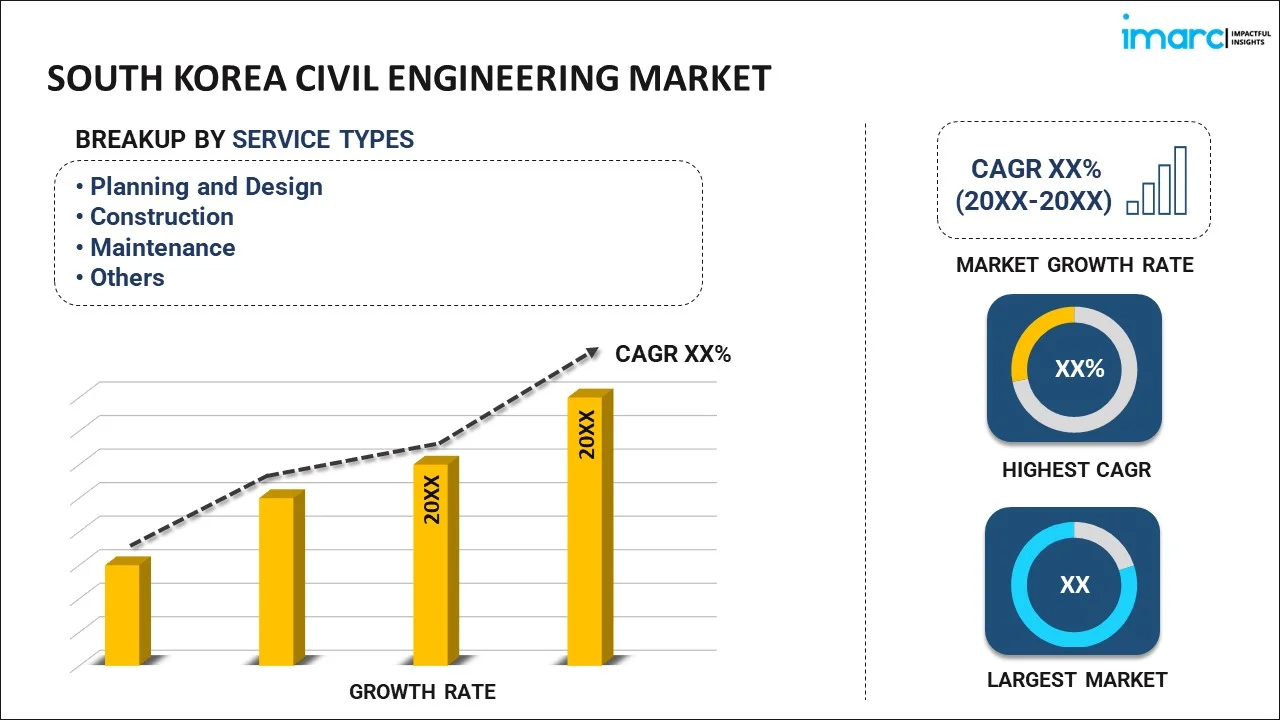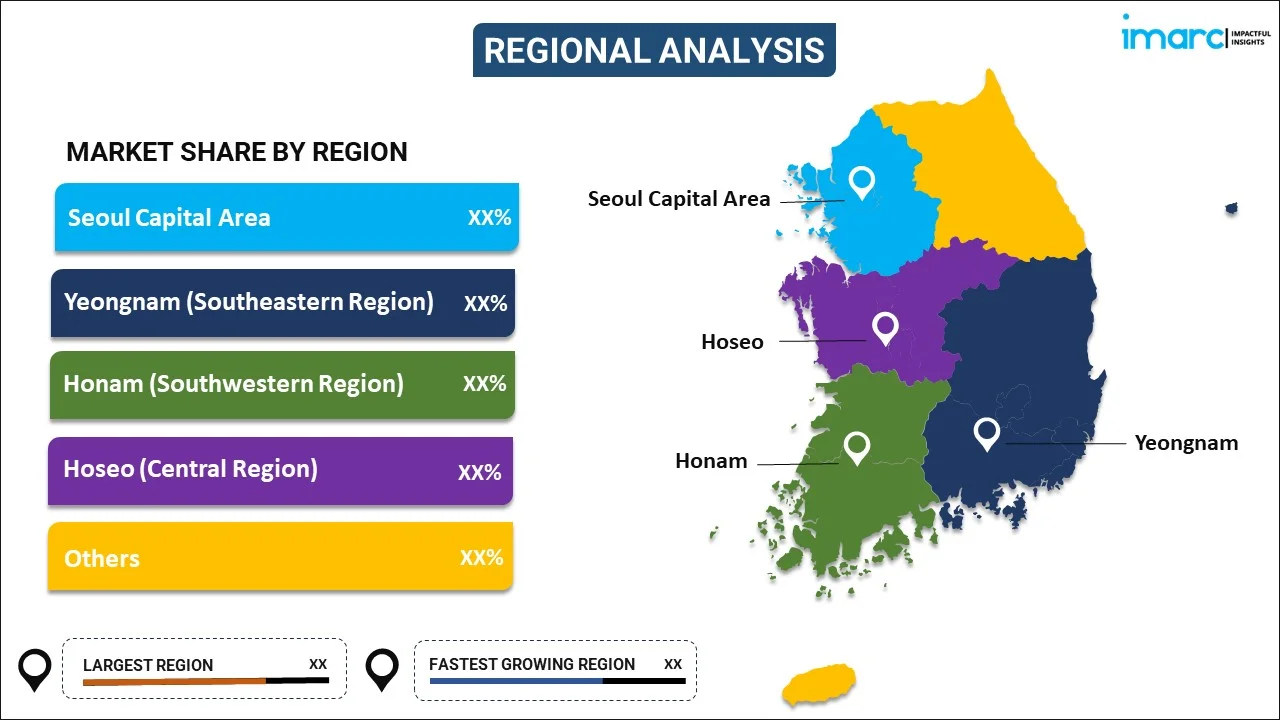
South Korea Civil Engineering Market Report by Service Type (Planning and Design, Construction, Maintenance, and Others), Application (Real Estate, Infrastructure, Industrial), End User (Government, Private, and Others), and Region 2024-2032
Market Overview:
The South Korea civil engineering market size is projected to exhibit a growth rate (CAGR) of 6.00% during 2024-2032. The rising investment in large-scale infrastructure projects, such as highways, railways, bridges, and ports, the integration of advanced technologies in civil engineering projects, and the development of renewable energy sources, such as solar and wind power represent some of the key factors driving the market.
|
Report Attribute
|
Key Statistics
|
|---|---|
|
Base Year
|
2023 |
|
Forecast Years
|
2024-2032 |
|
Historical Years
|
2018-2023
|
| Market Growth Rate (2024-2032) | 6.00% |
Civil engineering is a professional engineering discipline that involves the planning, design, construction, and maintenance of various infrastructure and construction projects that benefit society. It encompasses a wide range of activities related to the built environment, including buildings, bridges, roads, dams, airports, water supply and treatment systems, sewage and wastewater systems, and more. Civil engineers often contribute to urban and regional planning by designing land use plans, infrastructure layouts, and transportation networks to promote sustainable and efficient development in cities and regions. They also work on projects related to the management, distribution, and conservation of water resources. They design water supply systems, flood control measures, and hydraulic structures like dams and reservoirs. In addition, environmental engineers address issues related to environmental protection and sustainability. They design systems for wastewater treatment, air pollution control, and solid waste management, aiming to minimize the environmental impact of infrastructure projects. Additionally, civil engineers collaborate with professionals from various disciplines, including architects, environmental scientists, and urban planners, to create functional, sustainable, and safe infrastructure that improves the quality of life for communities and societies.
South Korea Civil Engineering Market Trends:
South Korea has a strong focus on infrastructure development, including transportation, energy, and water resources. The government's investment in large-scale infrastructure projects, such as highways, railways, bridges, and ports, is a significant driver of the civil engineering market. In addition, the South Korean government has introduced various initiatives and policies to stimulate the construction and infrastructure sectors. These initiatives include public-private partnerships (PPPs), investment in smart city projects, and incentives for sustainable and green infrastructure development. Besides, the country is known for its technological advancements and innovation. The integration of advanced technologies, such as Building Information Modeling (BIM), in civil engineering projects is improving project efficiency, reducing costs, and enhancing the quality of infrastructure. Moreover, South Korea is investing heavily in expanding its transportation networks, including high-speed rail, subway systems, and airports. These investments are aimed at improving connectivity within the country and enhancing international trade. Additionally, the development of renewable energy sources, such as solar and wind power, requires civil engineering expertise for the construction of energy facilities and associated infrastructure. Consequently, South Korea's commitment to renewable energy is a driver for civil engineering projects in this sector. Furthermore, South Korean engineering firms often collaborate with international partners on large-scale projects, contributing to the growth of the civil engineering sector and expanding opportunities for expertise exchange.
South Korea Civil Engineering Market Segmentation:
IMARC Group provides an analysis of the key trends in each segment of the market, along with forecasts at the country level for 2024-2032. Our report has categorized the market based on service type, application, and end user.
Service Type Insights:

- Planning and Design
- Construction
- Maintenance
- Others
The report has provided a detailed breakup and analysis of the market based on the service type. This includes planning and design, construction, maintenance, and others.
Application Insights:
- Real Estate
- Infrastructure
- Industrial
A detailed breakup and analysis of the market based on the application have also been provided in the report. This includes real estate, infrastructure, and industrial.
End User Insights:
- Government
- Private
- Others
The report has provided a detailed breakup and analysis of the market based on the end user. This includes government, private, and others.
Regional Insights:

- Seoul Capital Area
- Yeongnam (Southeastern Region)
- Honam (Southwestern Region)
- Hoseo (Central Region)
- Others
The report has also provided a comprehensive analysis of all the major regional markets, which include Seoul Capital Area, Yeongnam (Southeastern Region), Honam (Southwestern Region), Hoseo (Central Region), Others.
Competitive Landscape:
The market research report has also provided a comprehensive analysis of the competitive landscape. Competitive analysis such as market structure, key player positioning, top winning strategies, competitive dashboard, and company evaluation quadrant has been covered in the report. Also, detailed profiles of all major companies have been provided.
South Korea Civil Engineering Market Report Coverage:
| Report Features | Details |
|---|---|
| Base Year of the Analysis | 2023 |
| Historical Period | 2018-2023 |
| Forecast Period | 2024-2032 |
| Units | US$ Million |
| Scope of the Report | Exploration of Historical Trends and Market Outlook, Industry Catalysts and Challenges, Segment-Wise Historical and Future Market Assessment:
|
| Service Types Covered | Planning and Design, Construction, Maintenance, Others |
| Applications Covered | Real Estate, Infrastructure, Industrial |
| End Users Covered | Government, Private, Others |
| Regions Covered | Seoul Capital Area, Yeongnam (Southeastern Region), Honam (Southwestern Region), Hoseo (Central Region), Others |
| Customization Scope | 10% Free Customization |
| Report Price and Purchase Option | Single User License: US$ 3699 Five User License: US$ 4699 Corporate License: US$ 5699 |
| Post-Sale Analyst Support | 10-12 Weeks |
| Delivery Format | PDF and Excel through Email (We can also provide the editable version of the report in PPT/Word format on special request) |
Key Questions Answered in This Report:
- How has the South Korea civil engineering market performed so far and how will it perform in the coming years?
- What has been the impact of COVID-19 on the South Korea civil engineering market?
- What is the breakup of the South Korea civil engineering market on the basis of service type?
- What is the breakup of the South Korea civil engineering market on the basis of application?
- What is the breakup of the South Korea civil engineering market on the basis of end user?
- What are the various stages in the value chain of the South Korea civil engineering market?
- What are the key driving factors and challenges in the South Korea civil engineering?
- What is the structure of the South Korea civil engineering market and who are the key players?
- What is the degree of competition in the South Korea civil engineering market?
Key Benefits for Stakeholders:
- IMARC’s industry report offers a comprehensive quantitative analysis of various market segments, historical and current market trends, market forecasts, and dynamics of the South Korea civil engineering market from 2018-2032.
- The research report provides the latest information on the market drivers, challenges, and opportunities in the South Korea civil engineering market.
- Porter's five forces analysis assist stakeholders in assessing the impact of new entrants, competitive rivalry, supplier power, buyer power, and the threat of substitution. It helps stakeholders to analyze the level of competition within the South Korea civil engineering industry and its attractiveness.
- Competitive landscape allows stakeholders to understand their competitive environment and provides an insight into the current positions of key players in the market.
Need more help?
- Speak to our experienced analysts for insights on the current market scenarios.
- Include additional segments and countries to customize the report as per your requirement.
- Gain an unparalleled competitive advantage in your domain by understanding how to utilize the report and positively impacting your operations and revenue.
- For further assistance, please connect with our analysts.
 Inquire Before Buying
Inquire Before Buying
 Speak to an Analyst
Speak to an Analyst
 Request Brochure
Request Brochure
 Request Customization
Request Customization




.webp)




.webp)












